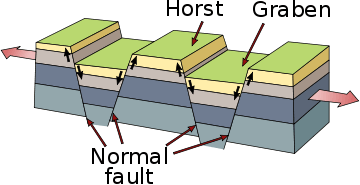Horst (geology)
In physical geography and geology, a horst is a raised fault block bounded by normal faults.[1] A horst is a raised block of the Earth's crust that has lifted, or has remained stationary, while the land on either side (graben) has subsided.[2] The word Horst in Dutch and German means heap – cognate with English "hurst".

The Vosges Mountains in France and Black Forest in Germany are examples of horsts, as are the Table, Jura, the Dole mountains and the Rila - Rhodope Massif including the well defined horsts of Belasitsa (linear horst), Rila mountain (vaulted domed shaped horst) and Pirin mountain - a horst forming a massive anticline situated between the complex graben valleys of Struma and that of Mesta.[3][4][5] The word also applies to larger areas, such as the Russian Plain, Arabia, India and Central South Africa, where the continent remains stable, with horizontal table-land stratification, in distinction to folded regions such as some mountain chains of Eurasia.[2]
The Midcontinent Rift System in North America is marked by a series of horsts extending from Lake Superior to Kansas.[6]
Geomorphology
Horsts may have either symmetrical or asymmetrical cross-sections. If the normal faults to either side have similar geometry and are moving at the same rate, the horst is likely to be symmetrical and roughly flat on top. If the faults on either side have different rates of vertical motion, the top of the horst will most likely be inclined and the entire profile will be asymmetrical. Erosion also plays a significant role in how symmetrical a horst appears in cross-section.
Horsts and hydrocarbon exploration
In many rift basins around the world, the vast majority of discovered hydrocarbons are found in conventional traps associated with horsts. For example, much of the petroleum found in the Sirte Basin, Libya (of the order of tens of billions of barrels of reserves) are found on large horst blocks such as the Zelten Platform and the Dahra Platform and on smaller horsts such as the Gialo High and the Bu-Attifel Ridge.
References
- Fossen H. (2010-07-15). Structural Geology. Cambridge University Press. p. 154. ISBN 9781139488617.
-

- Geographic Dictionary of Bulgaria 1980, p. 368
- Dimitrova & al 2004, p. 53
- Donchev & Karakashev 2004, pp. 128–129
- United States Geological Survey (1989). "Clastic Rocks Associated with the Midcontinent Rift System in Iowa" (PDF). U.S. GEOLOGICAL SURVEY BULLETIN 1989–I: 11. Retrieved Sep 3, 2018.